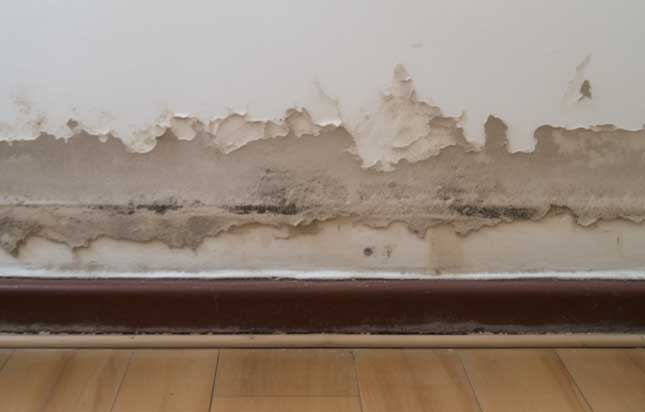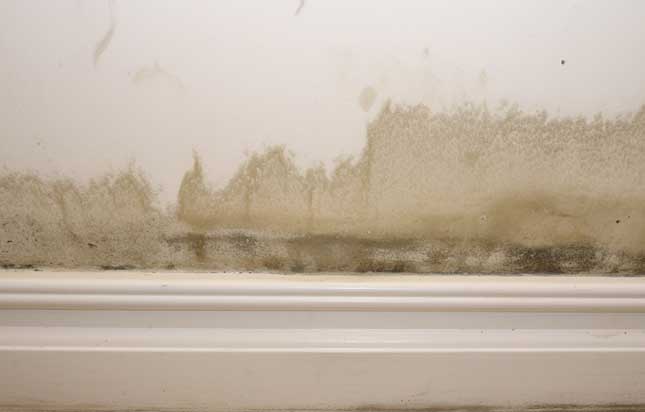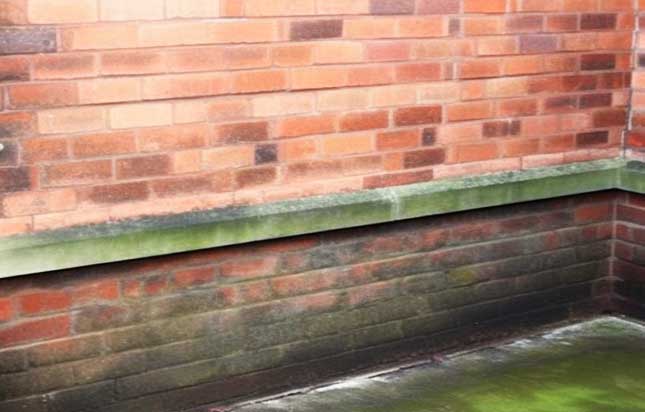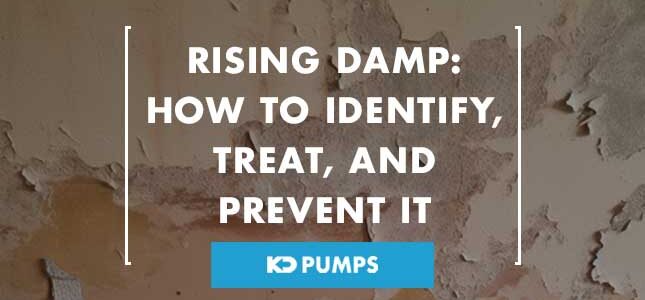Rising Damp: How to Identify, Treat & Prevent It
Rising damp might sound harmless, but it’s a silent troublemaker that can wreak havoc in our homes.
Understanding its origins, signs, and effective treatment methods is crucial for homeowners.
In this article we will explore its definition, identification, causes, and practical solutions.
From internal walls to external surfaces, we’ll walk you through the steps to treat and prevent this common household woe.
Article Chapters
What is Rising Damp?
Rising damp is a gradual and damaging process that happens when groundwater seeps upwards through a building’s walls due to capillary action.
This phenomenon occurs in porous materials such as bricks and mortar.
Groundwater, laden with moisture, is absorbed by these materials at the base of the walls.
As the moisture infiltrates, it gradually rises vertically.
This slow ascent, often unnoticed at first, carries salts and other contaminants from the ground into the structural elements of the building.
As this moisture moves upwards, it brings with it dissolved salts and minerals from the ground.
Over time, this constant rising dampness results in visible signs on interior and exterior walls.
Externally, damp brickwork might show signs of crumbling, and the mortar may weaken due to the continuous moisture exposure.
Rising damp, if left untreated, can compromise the structural integrity of a building, leading to more severe issues.
How to Identify Rising Damp?
Identifying rising damp is crucial as it often starts subtly, gradually worsening over time if left unaddressed. There are several telltale signs to watch out for:
Tide Marks
One of the most noticeable signs of rising damp is the presence of tide marks on walls.
These marks, caused by salts and minerals carried by the rising moisture, appear as discoloured bands along the lower sections of the walls.
They indicate the highest point the moisture has reached before evaporating.
Peeling Paint and Discoloured Plaster

Rising damp can lead to the deterioration of paint and plaster.
As the moisture rises, it can cause the paint to peel and plaster to discolour.
These visible changes are often early indicators of a rising damp issue.
Musty Odour
A musty, damp smell in certain areas of the house, especially near walls, can indicate rising damp.
This noticeable smell is a result of the mould and mildew growth facilitated by the continuous moisture seepage.
Damp or Decaying Skirting Boards
Skirting boards in contact with rising damp may become damp, soft, or even decay over time.
If you notice these boards deteriorating, it’s a clear sign of moisture infiltration.
Discoloured Patches
Look for discoloured patches on walls, especially near the base.
These patches are often darker than the surrounding areas and can indicate the presence of moisture.
Salt Deposits
Rising damp often carries salts from the ground into the walls.
As the moisture evaporates, these salts are left behind, forming white, powdery deposits on the affected areas.
These deposits are a clear indication of rising damp.
Rotting Wood
In severe cases, rising damp can affect wooden structures near the affected walls.
Rotting wood near the base of walls signifies prolonged exposure to moisture, possibly due to rising damp.
What Causes Rising Damp?
Rising damp can cause significant issues in buildings, but comprehending its origins is essential for effective treatment and prevention.
Absence or Deterioration of Damp-Proof Course (DPC)
Rising damp occurs when there’s either no damp-proof course or if the existing DPC has deteriorated over time.
In older constructions, damp-proof courses might be rudimentary or entirely absent, making them highly vulnerable to rising damp.
These courses, often made from materials like slate, bitumen, or plastic, lose their effectiveness over decades due to wear and tear, eventually allowing moisture to infiltrate the walls.
Porous Building Materials
Rising damp targets materials with high porosity, such as bricks, mortar, and certain types of stone.
These materials absorb water like a sponge, especially in the absence of a functional DPC.
Once the moisture seeps in, it rises through capillary action, causing visible damage to walls, plaster, and paint.
Bridge DPC
Another cause of rising damp can be the bridging of the damp-proof course.
This occurs when the ground level outside the building rises above the level of the DPC.
This ‘bridging’ enables water to bypass the DPC, leading to moisture infiltration.
Faulty Construction
In some cases, rising damp is a consequence of poor construction practices.
Faulty installations, where DPCs are improperly placed or materials are not of adequate quality, can lead to rising damp even in newer buildings.
Plumbing Leaks and Condensation
Although rising damp primarily arises from the ground, plumbing leaks, floods, or condensation, issues can mimic similar signs to that of penetrating damp.
For example, having a flooded basement could lead to long term rising damp issues.
It’s crucial to differentiate between these sources, ensuring accurate diagnosis and appropriate treatment.
How to Treat and Prevent Rising Damp on Internal Walls?

Addressing rising damp on internal walls is crucial to prevent structural damage and maintain a healthy living environment.
Here’s a detailed guide on how to effectively treat this issue:
Assessment and Damaged Plaster Removal
The first step is a thorough assessment of the affected area.
Damaged plaster, which often crumbles due to moisture, must be carefully removed.
This step is essential as it allows the wall to breathe, enabling proper drying and preventing the recurrence of dampness.
Installation of a New DPC
Installing a new damp-proof course is pivotal in treating rising damp. In modern methods, a chemical damp-proof course is often injected into the wall.
This process involves drilling holes at regular intervals along the affected area’s mortar joints and injecting a damp-proofing solution.
This injected substance forms a waterproof barrier, preventing moisture from rising further.
Replastering with Waterproof Render
After the DPC installation, the wall needs to be replastered using a waterproof render.
This specialised render is designed to resist moisture, ensuring a durable and long-lasting finish.
Applying this waterproof render creates an additional barrier against dampness, enhancing the effectiveness of the newly installed damp-proof course.
Addressing Interior Damage
Rising damp often damages interior elements like skirting boards and floorings.
It’s crucial to assess and, if necessary, repair or replace these elements to prevent further issues.
Damp or decaying skirting boards are common signs of rising damp and need immediate attention.
Improving Ventilation
Adequate ventilation is essential in preventing the recurrence of rising damp.
Ensuring proper airflow within the affected area helps in the natural drying process, maintaining the integrity of the newly installed damp-proof course.
Regular Maintenance
Regular checks and maintenance are vital in keeping rising damp at bay.
Homeowners should inspect internal walls periodically, especially in areas prone to dampness.
Early detection of any signs of rising damp can prevent significant damage and costly repairs.
How to Treat and Prevent Rising Damp on External Walls?

Dealing with rising damp on external walls is critical to safeguard a building’s structural integrity.
Here’s a detailed guide on how to treat rising damp on external walls effectively:
Exposing the Affected Area
The initial step involves exposing the affected section of the external wall.
This may require removing external render or damaged bricks to access the underlying substrate.
Careful removal ensures that the structure is not further compromised during the process.
Removing Damaged Render or Brickwork
Damaged render or brickwork, which often harbours moisture, must be entirely removed.
Thorough removal ensures that no dampness remains trapped within the wall structure, allowing for effective treatment.
Applying a DPC
Once the area is exposed and cleaned, a new damp-proof course needs to be applied.
This can be done using liquid or cream-based DPCs.
They penetrate the porous materials, forming a waterproof barrier against rising moisture.
The choice between liquid or cream-based DPCs depends on the specific requirements of the wall and the recommendations of a professional.
Selecting the Right Render or Coating
Choosing an appropriate render or coating is crucial in preventing future dampness.
Waterproof renders and specialised coatings designed to repel moisture should be applied to the external wall surface.
These materials act as an additional layer of protection, ensuring that water cannot penetrate the wall’s exterior.
The selection process should consider the wall’s material, climate conditions, and the level of exposure to rainfall and humidity.
Enhancing Drainage Systems
Improving the external drainage systems can complement the treatment process.
Properly functioning gutters, downspouts, and drainage channels redirect rainwater away from the walls.
This reduces the chances of water seepage and aids in maintaining the effectiveness of the newly applied damp-proof course.
Regular Inspection and Maintenance
After the treatment, regular inspection and maintenance are essential.
Periodically checking the external walls for signs of dampness and promptly addressing any issues can prevent the recurrence of rising damp.
Timely maintenance ensures the longevity of the treatment and the overall integrity of the building’s structure.
Conclusion
In the battle against rising damp, knowledge is your greatest weapon.
Identifying the signs early, understanding its origins, and implementing effective treatments can save your home from significant structural damage.
By following the steps outlined in this article, you’re equipped to tackle rising damp, ensuring your home remains dry and safe.


Comments are closed.